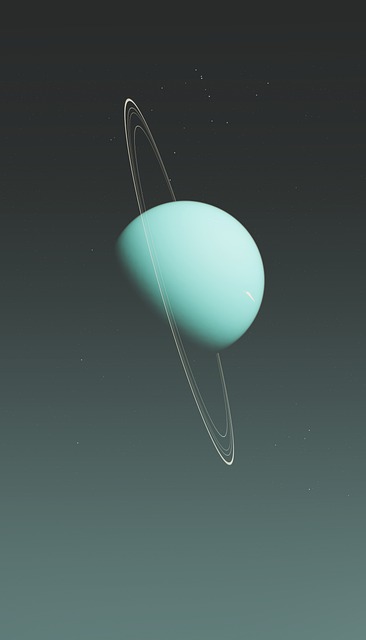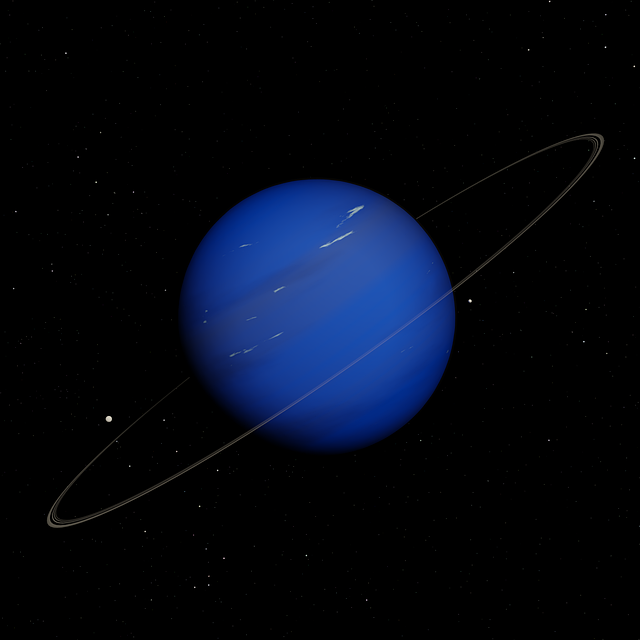By Tim Lambert
The Planet Uranus
In 1781 William Herschel discovered the planet Uranus. Since ancient times only 6 planets had been known, Mercury, Venus, Earth, Mars, Jupiter, and Saturn. The discovery of a previously unknown planet was a landmark and it made William Herschel famous. Herschel wanted to name the new planet Georgium Sidus after George III but instead, it was given the name Uranus. (Uranus was an ancient Greek god of the sky).
Meanwhile, in 1787 William Herschel also discovered 2 of the moons of Uranus, Titania, and Oberon. Two more moons of Uranus, Ariel, and Umbriel were discovered in 1851 by William Lassell. Miranda was discovered in 1948. Many more moons have since been discovered around Uranus. Today Uranus is known to have 28 moons.
As early as 1784 somebody calling himself Mr Vivenair wrote a story about a trip to Uranus in a balloon. However, Uranus featured little in science fiction.

In 1977 rings were discovered around Uranus. Then in 1986 Voyager 2 reached Uranus. It sent back detailed images of Uranus and its rings and discovered 11 new moons. Today (2024) Uranus is known to have 28 moons.
The Planet Neptune
Neptune was discovered in 1846. It was named after the Roman god of the sea. The same year Triton, one of the moons of Neptune was discovered. Nereid, another of the moons of Neptune was discovered in 1949. In 1976 rings were discovered around Neptune.
In 1989 Voyager 2 reached Neptune. So far it’s the only probe to reach the planet. Voyager 2 sent back detailed photos of the Neptune. It also flew close to the largest moon of Neptune, Triton. Voyager 2 also discovered several more moons orbiting Neptune. Today (2024) Neptune is known to have 16 moons.

Neptune appears in only a few science fiction stories (Perhaps because Neptune is so far from Earth and until recently little was known about it). However, in 1930 Olaf Stapleton wrote a book called First and Last Men. At the end of the story, the human race migrates to Neptune.
The Dwarf Planets
Pluto was discovered by Clyde Tombaugh in 1930 and at first, it was considered a planet. It was named after the Roman god of the dead. (The name Pluto was suggested by an 11-year-old girl called Venetia Burney). Then in 1978, a moon of Pluto called Charon was discovered. (In Greek mythology Charon was the boatman who ferried the dead across the River Styx).
In 2005 two small moons around Pluto were discovered. They are named Nix and Hydra. Today (2024) Pluto is known to have 5 moons. However, in 2006 Pluto was downgraded from a planet to a dwarf planet.
In 1996 the Hubble telescope took photos of Pluto. The New Horizons probe was launched by NASA in 2006. It reached Pluto and Charon in July 2015.
Meanwhile, In 2003 astronomers discovered a dwarf planet, called Sedna after an Inuit goddess of the sea. Sedna is reddish. So far Sedna is the farthest known dwarf planet from the Sun. In 2004 astronomers discovered a dwarf planet called Haumea. (In Hawaiian mythology she was the goddess of fertility and childbirth). Haumea is an oval object and it rotates very rapidly (a ‘day’ on Haumea lasts less than 4 hours). It takes 285 years to orbit the Sun. Haumea has two small moons. Haumea also has rings.
In 2005 another dwarf planet, called Makemake was discovered. (Makemake was a god of the people of Easter Island). Makemake takes about 305 years to orbit the Sun and it has a moon. Also, in 2005 astronomers discovered another dwarf planet, called Eris. (Eris was the Greek goddess of discord). Eris is slightly smaller than Pluto and it takes about 558 years to orbit the Sun. It has a moon called Dysnomia.
Varuna is another heavenly body past Neptune but it has not yet been officially classified as a dwarf planet. (objects have to meet certain criteria to be classed as dwarf planets). Varuna was discovered in 2000.
Another possible dwarf planet called Ixion was discovered in 2001 (it was named after a figure in Greek mythology). Yet another, called Quaor was discovered in 2002 (it was named after a Native American god). Another possible dwarf planet is called Orcus. It was discovered in 2004. Orcus is named after the Etruscan god of the underworld. It has a large moon called Vanth, after an Etruscan goddess.
A very distant object, also a possible dwarf planet was discovered in 2015. It’s called The Goblin. It takes about 32,000 years to orbit the Sun. Many astronomers believe there may be another planet (not a dwarf planet) very distant from the Sun.
Last revised 2025